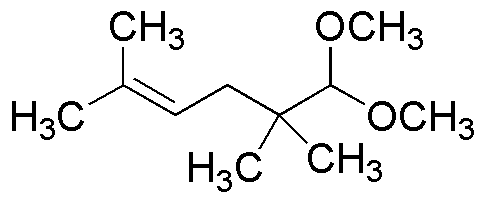Methyl pamplemousee is widely utilized in research focused on:
- Fragrance Industry: This compound is a key ingredient in perfumes and scented products, providing a fresh, citrus aroma that enhances the overall fragrance profile.
- Food and Beverage Flavoring: It is used as a flavoring agent in various food products, particularly in beverages, to impart a unique grapefruit-like taste that appeals to consumers.
- Cosmetics: Methyl pamplemousee is incorporated into skincare and cosmetic formulations for its pleasant scent and potential skin benefits, making products more appealing to users.
- Pharmaceuticals: This compound can be used in the development of medicinal products, particularly those aimed at improving flavor in pediatric formulations, ensuring better patient compliance.
- Research Applications: It serves as a model compound in studies related to fragrance chemistry and flavor synthesis, helping researchers develop new products and understand sensory interactions.
General Information
Properties
Safety and Regulations
Applications
Methyl pamplemousee is widely utilized in research focused on:
- Fragrance Industry: This compound is a key ingredient in perfumes and scented products, providing a fresh, citrus aroma that enhances the overall fragrance profile.
- Food and Beverage Flavoring: It is used as a flavoring agent in various food products, particularly in beverages, to impart a unique grapefruit-like taste that appeals to consumers.
- Cosmetics: Methyl pamplemousee is incorporated into skincare and cosmetic formulations for its pleasant scent and potential skin benefits, making products more appealing to users.
- Pharmaceuticals: This compound can be used in the development of medicinal products, particularly those aimed at improving flavor in pediatric formulations, ensuring better patient compliance.
- Research Applications: It serves as a model compound in studies related to fragrance chemistry and flavor synthesis, helping researchers develop new products and understand sensory interactions.
Documents
Safety Data Sheets (SDS)
The SDS provides comprehensive safety information on handling, storage, and disposal of the product.
Product Specification (PS)
The PS provides a comprehensive breakdown of the product’s properties, including chemical composition, physical state, purity, and storage requirements. It also details acceptable quality ranges and the product's intended applications.
Certificates of Analysis (COA)
Search for Certificates of Analysis (COA) by entering the products Lot Number. Lot and Batch Numbers can be found on a product’s label following the words ‘Lot’ or ‘Batch’.
*Catalog Number
*Lot Number
Certificates Of Origin (COO)
This COO confirms the country where the product was manufactured, and also details the materials and components used in it and whether it is derived from natural, synthetic, or other specific sources. This certificate may be required for customs, trade, and regulatory compliance.
*Catalog Number
*Lot Number
Safety Data Sheets (SDS)
The SDS provides comprehensive safety information on handling, storage, and disposal of the product.
DownloadProduct Specification (PS)
The PS provides a comprehensive breakdown of the product’s properties, including chemical composition, physical state, purity, and storage requirements. It also details acceptable quality ranges and the product's intended applications.
DownloadCertificates of Analysis (COA)
Search for Certificates of Analysis (COA) by entering the products Lot Number. Lot and Batch Numbers can be found on a product’s label following the words ‘Lot’ or ‘Batch’.
*Catalog Number
*Lot Number
Certificates Of Origin (COO)
This COO confirms the country where the product was manufactured, and also details the materials and components used in it and whether it is derived from natural, synthetic, or other specific sources. This certificate may be required for customs, trade, and regulatory compliance.

